Leonardo da Vinci: life, works, masterpieces, genius
The figure of Leonardo da Vinci (Vinci, 1452 - Amboise, 1519) is one of the most fascinating in the entire history of art: his life and works are able to fascinate everyone, even those who are not art experts or do not often frequent museums and exhibitions. More than any of his contemporaries, Leonardo da Vinci was the personage who embodied the model of the ideal man of Humanism and the Renaissance: the great Tuscan artist was a man thirsty for knowledge, his interests spanned all fields (he was a painter, scientist, inventor, musician, engineer, treatise writer, anatomical scholar... and much more). To his interests it is then necessary to add some elements of his personality contrary to the common feeling of the time: for example, he was not a believer, or at any rate he did not nurture the same religious sense as his contemporaries (as Giorgio Vasari writes in the Lives, albeit only in the 1550 edition: “he did not approach any religion, estimating per avventura much more to be a philosopher than a Christian,” a consideration later removed in the later edition perhaps so as not to compromise too much, in the age of the Counter-Reformation, the memory of Leonardo). Leonardo preferred to observe the world with reason rather than faith: in his view, nature is governed by an order that, through its laws, regulates all phenomena occurring in the world, and the task of the scientist is to discover these laws.
Leonardo’s art, consequently, is the child of this worldview: if science describes nature quantitatively, art, on the other hand, describes it qualitatively, so art and science are much closer than one might think. Other traits of his personality contribute to making him an unconventional man, such as his homosexuality (about which, however, we have contradictory information), or his practice of dissecting corpses (which, however, was already widespread in the medical field, and was subject to the laws of the Church: Leonardo was not even the only artist, for Antonio del Pollaiolo also resorted to dissecting bodies). Another of the aspects of Leonardo’s production that most intrigue the public is his writing from right to left, a practice that is anything but cryptic because the most likely hypothesis would have it that Leonardo, who was left-handed and therefore used his left hand in writing, preferred to write naturally by avoiding carrying ink with his hand.
The “sum” of all these aspects of the person Leonardo da Vinci has led to consider his figure as that of an extravagant and enigmatic man, a man with dark sides who therefore given his alleged mysterious nature would later conceal mysteries in his works as well. In Leonardo’s production, however, everything makes sense: his works do not conceal mysteries or strange esoteric messages, as they have long been attributed to him, especially recently. It is, more simply, the art of one of the greatest geniuses in history: and this is all very fascinating in itself. The figure of Leonardo da Vinci was central in several spheres, beginning with that of art: indeed, he had numerous followers and imitators, including Francesco Melzi and Gian Giacomo Caprotti, better known as the Salaì, two artists who were also his heirs as well as his pupils, to continue with others such as Marco d’Oggiono, Bernardino Luini, the Giampietrino, Giovanni Antonio Boltraffio, and Cesare da Sesto (the painters known as “leonardeschi”), but Leonardo’s sphere of influence goes far beyond that: the Tuscan painter, for example, was also relevant to the entire Venetian school, from Giorgione onward. Much of the mature Renaissance, in essence, is indebted to Leonardo da Vinci.
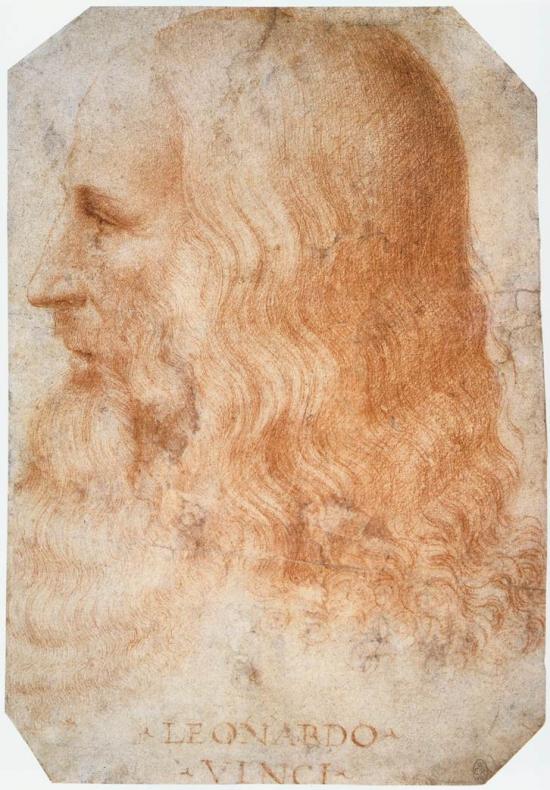 |
| Francesco Melzi, Portrait of Leonardo da Vinci (c. 1510; sanguine on paper, 275 x 190 mm; Windsor, Royal Collection) |
Leonardo da Vinci, biography
Leonardo di ser Piero da Vinci was born on April 15 in Anchiano, a village near Vinci, not far from Florence (Anchiano is home to a country mansion that tradition says was his birthplace: today it houses the Casa-Museo Leonardo da Vinci). His father was Piero, a notary by profession, and his mother was a woman of modest background, Caterina (Caterina di Meo Lippi or Caterina Buti del Vacca), perhaps a peasant woman, Piero’s mistress. Perhaps in 1469, at the age of seventeen, the young Leonardo moved to Florence: it was at this time, however, that he began to frequent the workshop of Andrea del Verrocchio. In August 1473 he produced his first known work, Landscape with River, a drawing preserved at the Gabinetto dei Disegni e delle Stampe in the Uffizi Gallery in Florence. Soon after, probably by about 1475, he finished his first major independent painting, theAnnunciation. During the same period he collaborated with Verrocchio on the very famous Baptism of Christ, also preserved in the Uffizi and datable to about 1475-1478. In about 1480 he began to frequent the circle of Lorenzo the Magnificent, and the following year he was commissioned to paint the famous Adoration of the Magi, one of his most extraordinary works(read an in-depth study of this important work).
In 1482, the artist moved to Milan where he worked for Ludovico il Moro, Duke of Milan, and where he remained until 1499. In 1483-84 he was commissioned to create an equestrian monument to Francesco Sforza with a rearing horse on its hind legs: the work was never completed. Also from the Milanese period probably dates his best-known drawing, namely theVitruvian Man. On the other hand, we know the exact dates of the Last Supper: his Last Supper is painted between 1494 and 1498, on the wall of the refectory of Santa Maria delle Grazie in Milan. In 1500, after the French occupation of Milan the previous year, Leonardo moved first to Mantua, to Isabella d’Este, and then to Venice, where he worked on some military projects. In 1501 he made a brief stay in Rome, where he was able to study works of classical antiquity.
In 1502 Leonardo da Vinci was again in Florence: meanwhile, the Medici had been driven out, Girolamo Savonarola had fallen, and the Florentine Republic had been established (meanwhile, in the same year, Leonardo worked for Cesare Borgia). It was precisely the Florentine Republic, in 1503, that entrusted him with some engineering projects in addition to the creation of the Battle of Anghiari, a fresco that was to decorate the Salone dei Cinquecento in the Palazzo Vecchio (along with Michelangelo Buonarroti’s Battle of Cascina ): Leonardo, after an unsuccessful trial, renounced theundertaking (read in detail the story of the undertaking). Michelangelo’s work will have the same outcome: the Battle of Cascina will also never see the light of day. In this period probably also the Mona Lisa: however, critics disagree on the exact date of its completion. What is certain is that Leonardo returned to Milan in 1508, under pressure from French governor Charles d’Amboise, and stayed in the Lombard capital until 1513. In the same year, Leonardo stayed in Rome to work for Pope Leo X: the artist was involved in some engineering work and continued his scientific studies. In 1516, the artist moved to France, to Amboise, at the invitation of King Francis I, bringing with him some paintings (including the Mona Lisa: read the article where we explain why the work is in France). Leonardo da Vinci died on May 2, 1519, at the manor of Clos-Lucé in Amboise, having made his will on April 23. His remains rest in Amboise.
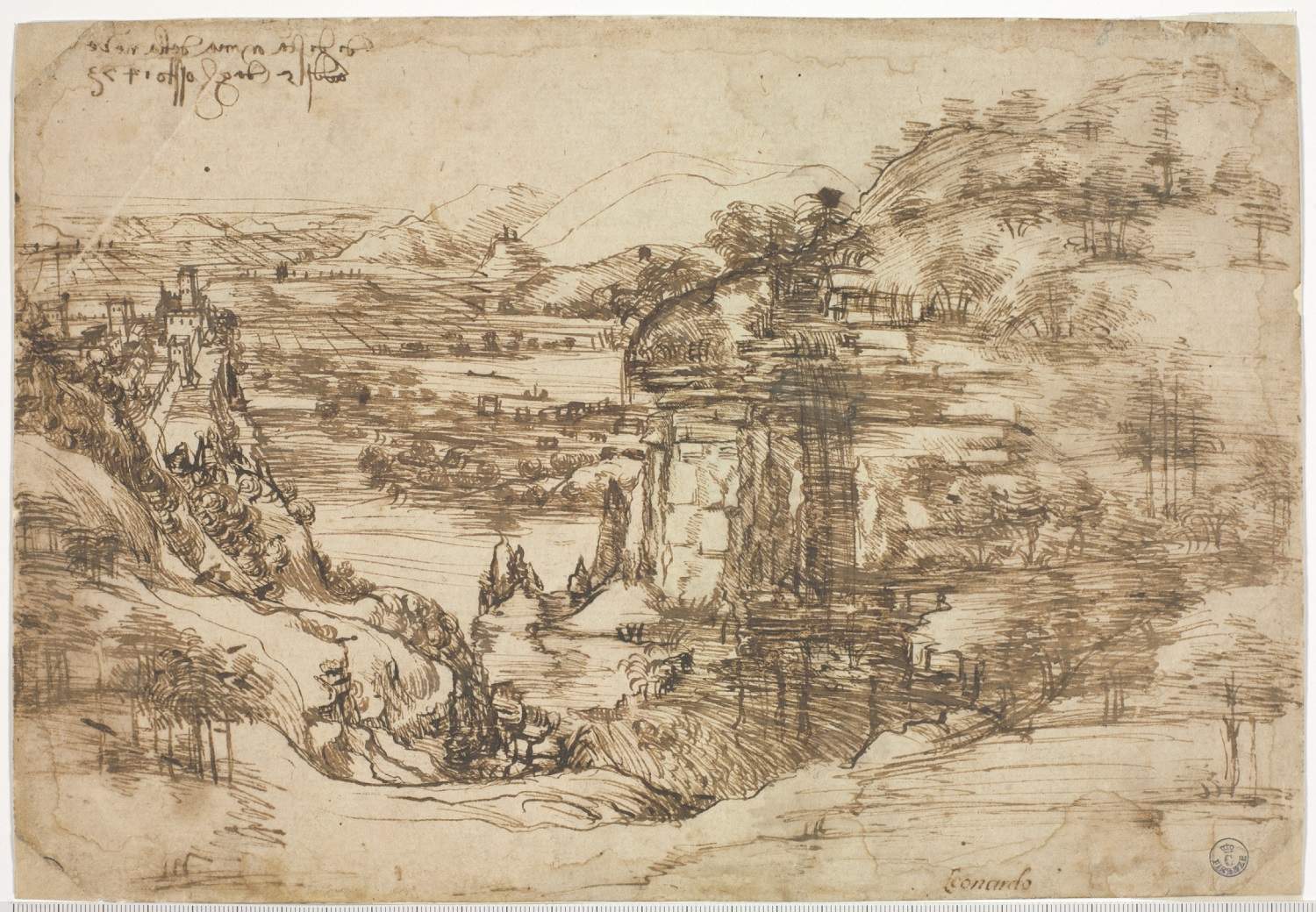 |
| Leonardo da Vinci, Landscape with River (1473; pen on yellowed white paper, 196 x 287 mm; Florence, Uffizi, Drawings and Prints Cabinet) |
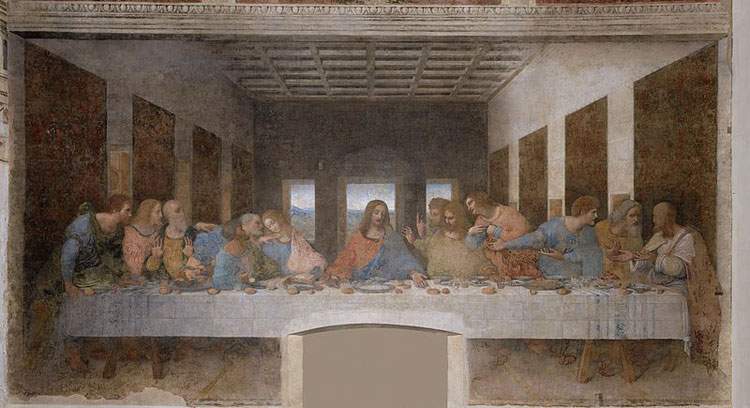 |
| Leonardo da Vinci, Last Supper (1494-1498; tempera on plaster, 460 x 880 cm; Milan, Santa Maria delle Grazie) |
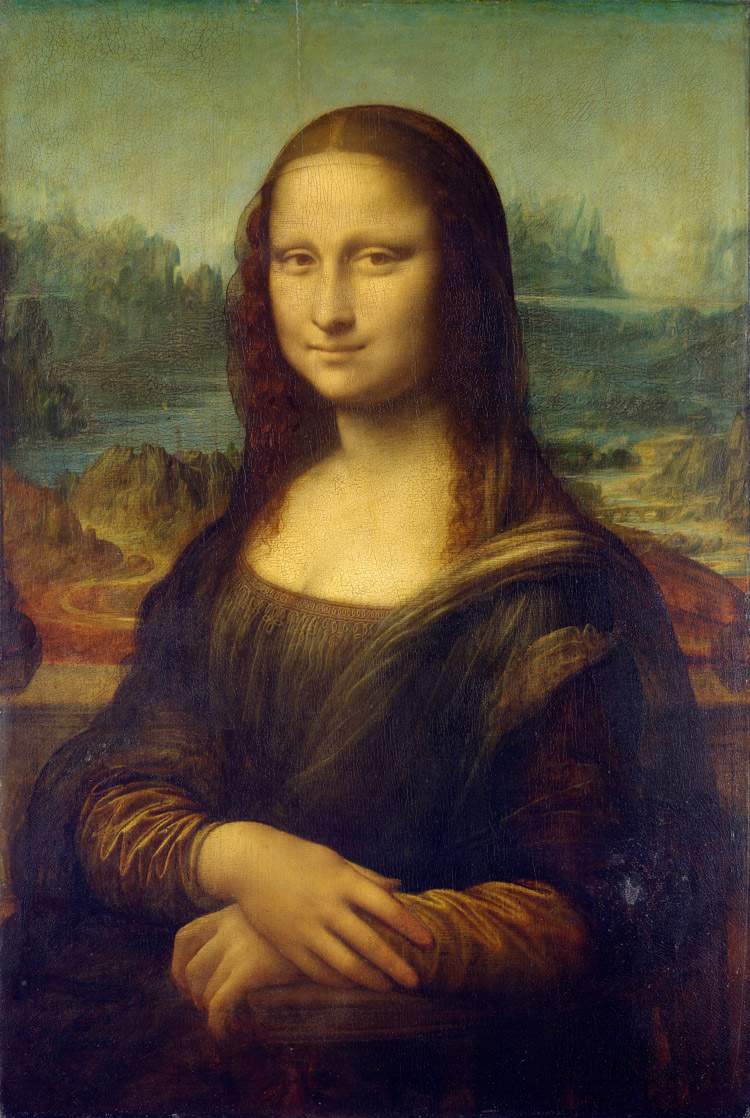 |
| Leonardo da Vinci, The Mona Lisa (c. 1503-1513; oil on panel, 77 x 53 cm; Paris, Louvre) |
Leonardo’s art, innovations: from the beginnings to the Adoration of the Magi
Leonardo da Vinci’s early works help us understand the painter’s training and how precocious his genius was and how innovative his art already was. We can begin the journey through Leonardo’s art from theAnnunciation(read also an in-depth discussion of the composition of the work), which dates from between 1472 and 1475, while the Baptism of Christ, a painting by Verrocchio in which Leonardo also participated, is perhaps slightly later and should date from the years between 1475 and 1478, but there is no certainty about the dates. Leonardo da Vinci entered Verrocchio’s workshop at a very young age, only seventeen years old. Verrocchio’s workshop was the most important in Florence at the time: some of the greatest artists of the time studied here, for example Sandro Botticelli, Pietro Perugino, Lorenzo di Credi, Domenico Ghirlandaio, and many others. The experience in Verrocchio’s workshop was crucial because here Leonardo da Vinci learned not only how to paint and draw but also notions of architecture and engineering that may have influenced his later studies. What’s more, Leonardo came from a country hamlet, so he had had the opportunity to study nature up close and become passionate about natural things, and these experiences would also prove fundamental to his art and studies. Vasari tells us in his Lives that Leonardo loved animals so much that when he had occasion he would go to those who sold caged birds and after buying them set them free to give them back their freedom. Leonardo’s drawings and paintings are after all full of elements taken from the natural world. TheAnnunciation is a painting still very much related to his school and environment: there is still outlining (which, however, is beginning to become much less sharp than that of his contemporaries), the Madonna’s lectern has decorations reminiscent of those in the tomb of Piero and Giuliano de’ Medici executed by Verrocchio, there is very extensive drapery. However, there are also several elements of great novelty, starting with the outdoor setting, in a garden: Leonardo decides to eliminate the loggia typical of the iconography of the theme, so the whole scene takes place outdoors. The artist then inserts a flowery meadow with different species of flowers that demonstrate Leonardo’s keen powers of observation, which can also be seen in the archangel’s wings that look like wings of a bird studied from life. Also worth noting is the use of aerial perspective, which had in Leonardo one of its pioneers (aerial perspective refers to the way of rendering the depth of a painting through the dimming of colors and the blurring of more distant objects: Leonardo had intuited that atmospheric dust and haze act as a screen between us and what we see, consequently the more distant the objects are, the more the dust between us and them accumulates and the more consequently the latter are seen as blurred).
In Verrocchio’s Baptism of Christ, Leonardo intervened on the head of the angel in profile, on Christ’s hair, on some parts of the landscape, and on the feet of the two main characters, whom we see immersed in water, and probably also on some passages of Christ’s body, because we see it much softer in the chiaroscuro passages than that of John the Baptist, which is totally Verrocchio’s work instead. The Uffizi work is very interesting because it allows us to compare the two immense painters in one painting, and in addition to the bodies of Christ and John the Baptist we can also see the differences in the angels because Leonardo’s is also softer than Verrocchio’s angel (it is already characterized by an early use of sfumato, which is not yet at its peak, since it is a youthful intervention, but we can already appreciate a detachment from the master who continues to use contour). Leonardo then infuses the feet of the characters immersed in water with a vivid naturalism, with the liquid element very naturally making what is immersed feel deformed.
The youthful journey closes with theAdoration of the Magi, one of the pinnacles of the Da Vinci painter’s entire career and a key painting for understanding Leonardo da Vinci’s depiction of “mental accidents” in his works, just like theLast Supper in Santa Maria delle Grazie. Painted between 1481 and 1482 for the monks of the Abbey of San Donato in Scopeto, it remained unfinished upon the artist’s departure for Milan (or perhaps it was deliberately suspended by Leonardo: read an interesting hypothesis about it). Leonardo took up anAdoration by one of his fellow students, Sandro Botticelli, also preserved in the Uffizi, which had innovated the theme in that it placed the group of the Holy Family at the center of the scene to form the focus, with the other characters around it (until then the Holy Family had been positioned to the side). For the first time in the history of art, an Epiphany in the most literal sense of the term, that is, a manifestation of divinity, is realized, and we can tell by the reactions of the onlookers: we see several people reacting in a very heartfelt way to the event, we see expressions of astonishment, wonder, and upset. This is a highly dramatic work that marks a significant departure from all previous “Adorations,” and it certainly sets an important precedent for the Last Supper. Leonardo also astonishes with his ability to depict people’s feelings with body expressions and movements, a skill hitherto unheard of.
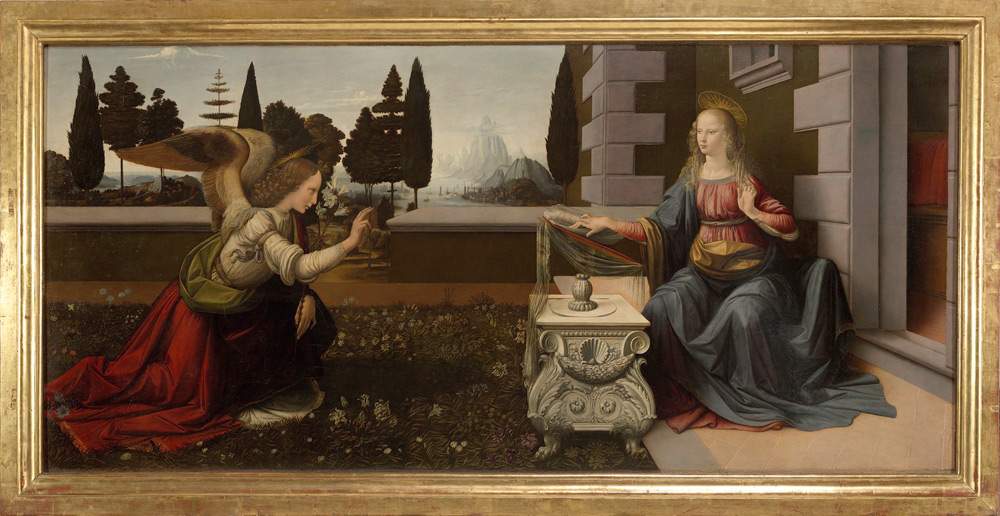 |
| Leonardo da Vinci, Annunciation (c. 1472-1475; oil and tempera on panel, 98 x 217 cm; Florence, Uffizi) |
 |
| Verrocchio and Leonardo da Vinci, Baptism of Christ (c. 1475-1478; tempera and oil on panel, 177 x 151 cm; Florence, Uffizi) |
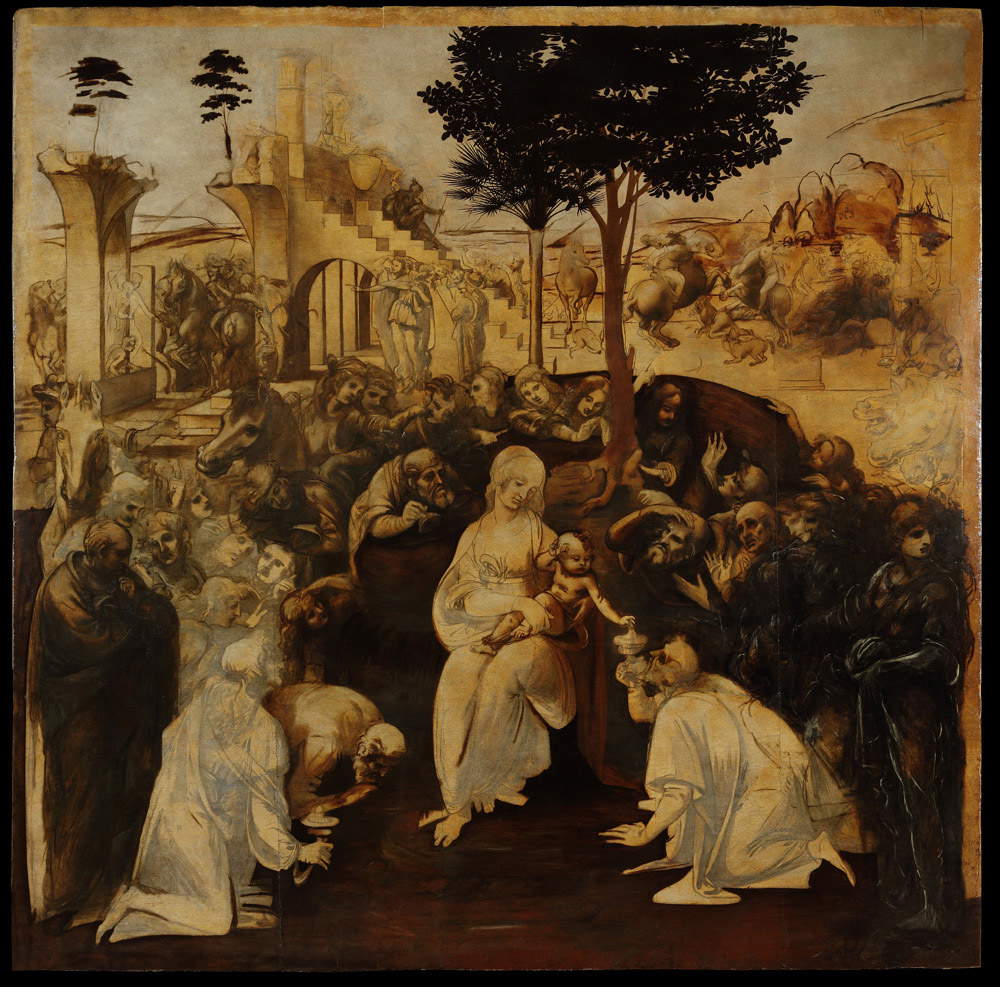 |
| Leonardo da Vinci, Adoration of the Magi (1481-1482; charcoal drawing, ink watercolor and oil on panel, 246 x 243 cm; Florence, Uffizi Gallery |
Leonardo da Vinci’s drawing and portraiture
Leonardo is also known for his drawings, which allow a lunge into the theme of Leonardo’s relationship with science. TheVitruvian Man, for example(read more about the work here), demonstrates the Leonardo idea that everything in nature can be measured: even the body of man can be inscribed in a circle and a square according to the canon of proportion that had been formulated by the great Roman architect Vitruvius in his treatise De Architectura. Leonardo had achieved a very high degree of excellence in drawing: his graphic achievements are very refined: for the artist it was not only an artistic medium, but it was also a means of investigating reality, of recording the results of his experiments and research, of inventing, explaining, and annotating. His drawings thus range over all fields: they obviously range from preparatory drawings for works to the depiction of nature (there are several drawings in which Leonardo depicts plants, flowers and animals), to, for example, drawings that record his geometric and scientific studies, such as those depicting the parts of the human body, geometric figures, but also those for engineering works. Then there are the drawings that the public finds more and more suggestive and fascinating, namely the drawings of inventions: Leonardo’s scientific studies intended to find practical application in the realization of engineering works, military works, hydraulic works, all the way to everyday tools or certainly futuristic inventions such as the famous flying machines. Drawing achieves an unprecedented versatility in Leonardo da Vinci, and it is also for this reason that there is still a large body of Leonardo’s drawings preserved in various collections around the world: it is precisely the drawings that constitute by far the most conspicuous part of his output.
Leonardo’s portraiture also denotes his passion for the natural: according to Leonardo da Vinci, the artist should not produce overly idealized portraits because he would run the risk of repeating the usual expressions, and since there is nothing “replicated” (to use the term Leonardo uses in his Treatise on Painting) in nature and “no one precisely resembles himself,” a mistake would be made. Leonardo’s portraits are therefore innovative precisely because of his willingness to study the subject’s face in great detail in order to render not only its appearance but also its state of mind, which is fundamental for Leonardo as every state of mind corresponds to an expression. Among his most significant portraits is the Belle Ferronnière(read more about the work here), which dates from the Milanese period and is distinguished by the use of sfumato, one of Leonardo’s great inventions: it is a very fine chiaroscuro, combined with brushstrokes with overlapping directions and subtle gradations of color, through which Leonardo eliminates the outline of the figures that was typical of the Florentine artistic tradition, and makes the figures almost blend with the surrounding atmosphere. It is Leonardo himself who expounds on this type of technique in his Treatise on Painting (though, of course, without calling it “sfumato”): “your shadows and lumens,” the artist suggests to the reader who intends to paint, “be united without strokes or marks for the use of smoke.” The idea of sfumato also stems from observation of reality: when we look at something in reality, we cannot establish its contours in a definite way (the “boundary” between light and shadow, in fact, participates in both light and shadow and can never be defined exactly, because its distance from light and dark is variable depending on the intensity of the light sources). Moreover, the shadow is actually colored, and its color is closer to its object the closer and more illuminated the object is, so even in paintings the shadow must have the color of its object. This is precisely observed in the Belle Ferronnière: its shadows have different shades and different colors depending on the illuminated parts to which they are set against. Such a wide variety in the making of shadows had never been achieved before and is one of Leonardo da Vinci’s major achievements.
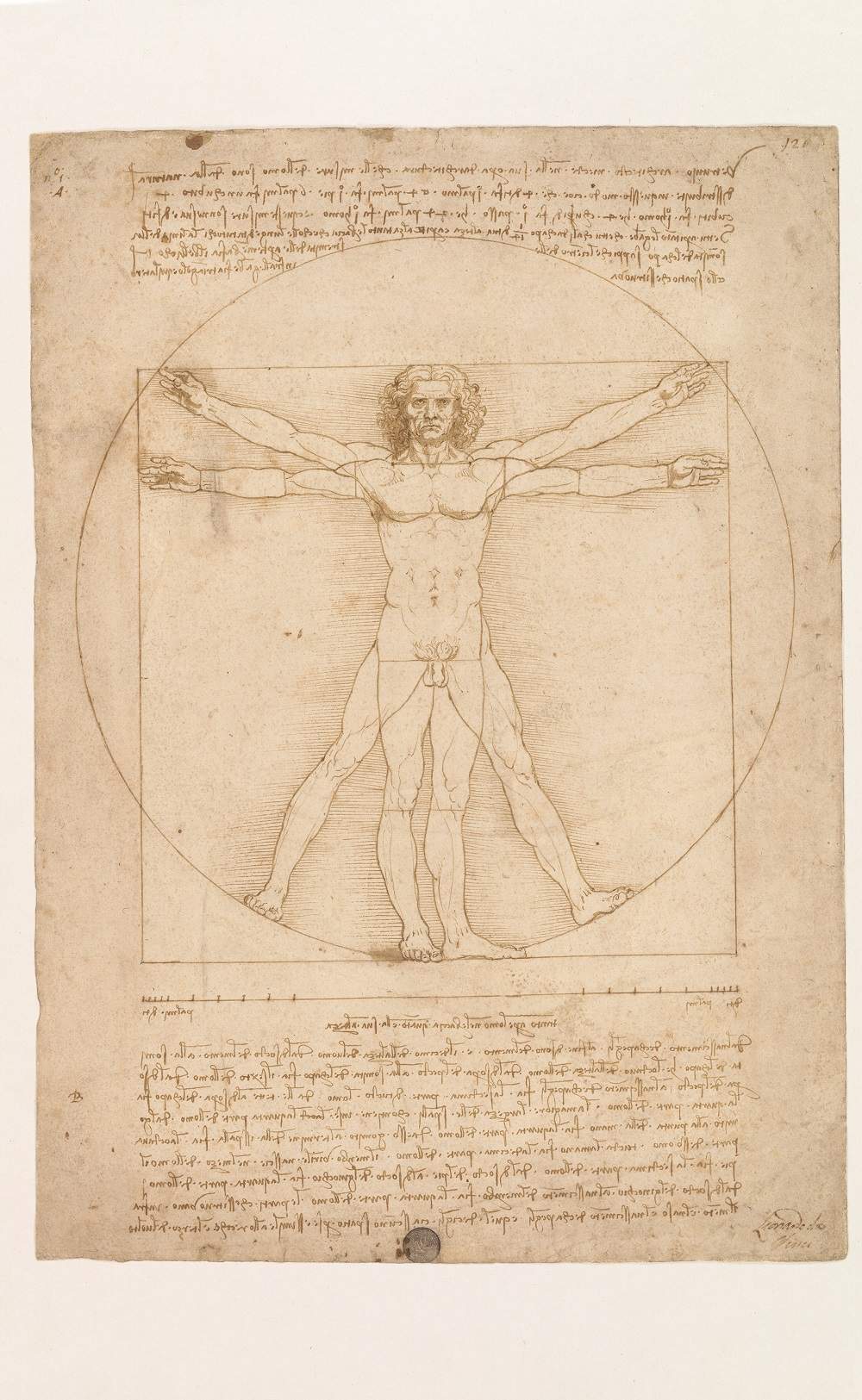 |
| Leonardo da Vinci, The Proportions of the Human Body According to Vitruvius - “Vitruvian Man” (c. 1490; metal point, pen and ink, touches of watercolor on white paper, 34.4 x 24.5 cm; Venice, Gallerie dell’Accademia) |
 |
| Leonardo da Vinci, Portrait of a Lady known as La Belle Ferronnière or alleged portrait of Lucrezia Crivelli (1493-1495; oil on panel, 63 x 45 cm; Paris, Louvre) |
Where to see the works of Leonardo da Vinci
Few paintings by Leonardo da Vinci have come down to us, but they are all celebrated masterpieces of art history. Much more copious are the drawings, which are often displayed at exhibitions, though never for extended periods for conservation reasons (drawings cannot be exposed to light for too long). The museum that holds the largest number of Leonardo da Vinci’s paintings is the Louvre in Paris: here one can admire the Mona Lisa, the first version of the Virgin of the Rocks, the Belle Ferronnière, Saint John the Baptist, and Saint Anne, the Virgin and Child. Next, there are the Uffizi, where one can admire theAnnunciation, theAdoration of the Magi and the Baptism of Christ where Leonardo intervened on Verrocchio’s painting. In Milan one can admire the Sala delle Asse, theLast Supper in Santa Maria delle Grazie, and the Ritratto di musico at the Pinacoteca Ambrosiana. Then there is only one other Italian museum that preserves a work by Leonardo da Vinci: it is the Galleria Nazionale in Parma, where the Scapiliata is located(read an in-depth look at the work here). At the Vatican Museums, on the other hand, one can admire the San Girolamo.
Outside Italy there are two masterpieces by Leonardo at the Hermitage in St. Petersburg: they are the Benois Madonna and the Litta Madonna. In contrast, the Madonna Dreyfus and the Portrait of Ginevra Benci can be admired at the National Gallery in Washington. The museums that preserve the remaining Leonardo paintings are the Alte Pinakothek in Munich (the Madonna of the Carnation), the Czartoryski Museum in Krakow (the Lady with an Ermine), and the National Gallery in London (the second version of the Virgin of the Rocks, as well as the cartoon of St. Anne in the Louvre).
 |
| Leonardo da Vinci: life, works, masterpieces, genius |
Warning: the translation into English of the original Italian article was created using automatic tools. We undertake to review all articles, but we do not guarantee the total absence of inaccuracies in the translation due to the program. You can find the original by clicking on the ITA button. If you find any mistake,please contact us.




























